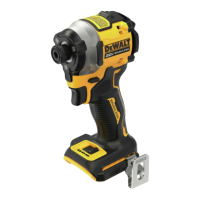10
ENGLISH
installing attachments or accessories. An accidental
start-up can causeinjury.
Proper Hand Position (Fig.A,C)
WARNING: To reduce the risk of serious personal injury,
ALWAYS use proper hand position asshown.
WARNING: To reduce the risk of serious personal
injury, ALWAYS hold securely in anticipation of a
suddenreaction.
Proper hand position requires one hand on the main
handle
10
.
Variable Speed Trigger Switch (Fig.A)
To turn the tool on, squeeze the trigger switch
1
. To turn the
tool off, release the trigger switch. Your tool is equipped with a
brake. The tool will stop when the trigger switch is fullyreleased.
The variable speed switch enables you to start the application at
a slow speed. The further you squeeze the trigger, the faster the
tool will operate. For maximum tool life, use variable speed only
for starting holes orfasteners.
NOTE: Continuous use in variable speed range is not
recommended. It may damage the switch and should
beavoided.
Forward/Reverse Control Button (Fig.A)
A forward/reverse control button
2
determines the direction of
the tool and also serves as a lock-offbutton.
To select forward rotation, release the trigger switch
1
and
depress the forward/reverse control button
2
on the right side
of thetool.
To select reverse, release the trigger switch
1
and depress
the forward/reverse control button
2
on the left side of the
tool. The centre position of the control button locks the trigger
switch in the off position. When changing the position of the
control button, be sure the trigger isreleased.
NOTE: The first time the tool is run after changing the direction
of rotation, you may hear a click on start up. This is normal and
does not indicate aproblem.
Worklights (Fig.A)
There are three worklights
7
located around the 6.35 mm hex
chuck
4
. The worklights are activated when the trigger switch
isdepressed.
When the trigger is released, the worklight will stay illuminated
for up to 20seconds.
NOTE: The worklights are for lighting the immediate work
surface and are not intended to be used as aflashlight.
Mode Selector (Fig.A,D)
Your tool is equipped with a mode selector
11
which allows
you to select one of three modes. Select the mode based on the
application and control the speed of the tool using the variable
speed trigger switch
1
.
Precision Drive (Fig.D)
In addition to normal impacting modes, this tool features the
Precision Drive mode which enables greater control in lighter
applications to avoid damage to materials or fasteners. It is ideal
for light applications such as cabinet hinge screws or machine
screws. Precision Drive mode will work as a screwdriver in light
applications, before hesitating as the screw head reaches the
work piece, and then (if required) start a slow controlled impact
to ensure the head ends perfectlyflush.
NOTE: This mode is for light duty screwdriving applications. If
the tool will not drive a fastener in Precision Mode, please select
mode 2 which will give the additional powerrequired.
DCF850
Mode 1 Precision Drive rpm 0–1000
Mode 2 Normal Impacting rpm 0–2800
Mode 3 High Speed Impacting rpm 0–3250
Quick-Release Chuck (Fig.A,E,F)
WARNING: Use only impact accessories. Non-impact
accessories may break and cause a hazardous condition.
Inspect accessory prior to use to ensure that it con tains
nocracks.
NOTE: The chuck accepts 6.35 mm hex accessoriesonly.
Place the forward/reverse button
2
in the lock-off (centre)
position or remove battery pack before changingaccessories.
To install an accessory, fully insert the accessory. The accessory is
locked into place (Fig.E).
To remove an accessory, pull the chuck collar
3
away from the
front of the tool. Remove the accessory (Fig.F).
Usage
Your impact tool generates the following maximum torque:
Cat # Nm
DCF850 205
CAUTION: Ensure fastener and/or system will withstand
the level of torque generated by the tool. Excessive torque
may cause breakage and possible personalinjury.
1. Place the accessory into the chuck. Keep the tool pointed
straight at the workpiece.
2. Press switch to start operation. Release the switch to stop
operation. Always check torque with a torque wrench, as
the fastening torque is affected by many factors including
the following:
- Voltage: Low voltage, due to a nearly discharged
battery, will reduce fasteningtorque.
- Socket size: Failure to use the correct socket size will
cause a reduction in fasteningtorque.
- Bolt Size: Larger bolt diameters generally require
higher fastening torque. Fastening torque will also vary
according to length, grade, and torquecoefficient.
- Bolt: Ensure that all threads are free of rust and other
debris to allow proper fasteningtorque.

